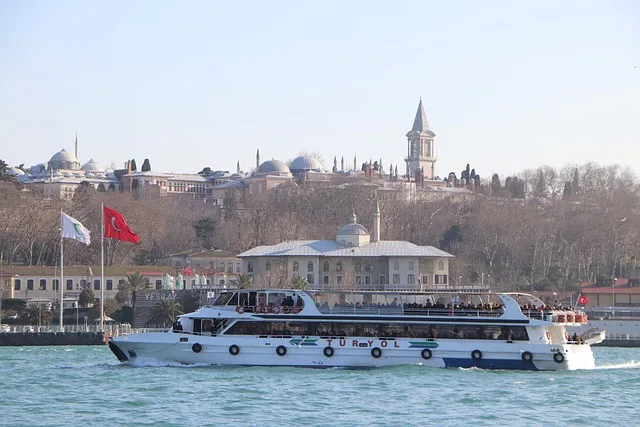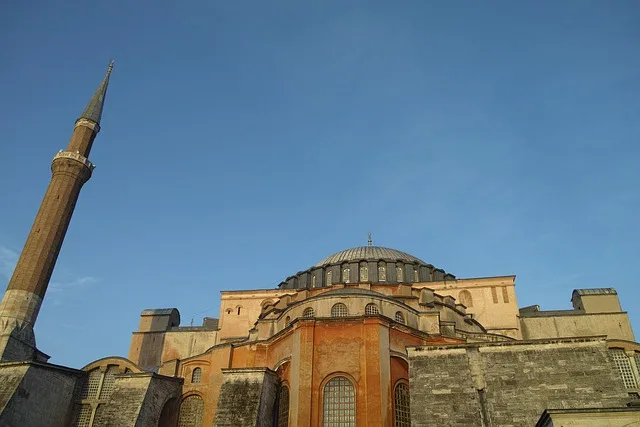
Constructed in 537 AD, the Hagia Sophia was originally a cathedral, and it held the title of the world’s largest cathedral for nearly a thousand years. Can you believe that? It’s like the heavyweight champion of churches! The sheer scale of its dome is mind-boggling, soaring high above like a giant’s hat, creating an ethereal atmosphere that leaves visitors in awe.

What’s truly fascinating is how the Hagia Sophia has transformed over the years. From a vibrant center of Orthodox Christianity to a mosque, and now a museum, it’s a living chronicle of cultural evolution. Each era has left its mark, adding layers of beauty and complexity. The intricate mosaics, with their shimmering gold backgrounds, depict biblical scenes that seem to come alive, inviting you to step into a different world.
Hagia Sophia: The Timeless Splendor of Byzantine Architecture Unveiled
Have you ever gazed up at a ceiling and felt your breath catch? That’s the magic of the Hagia Sophia. The massive dome, often described as floating, creates an ethereal atmosphere that leaves visitors in awe. It’s as if the heavens themselves are cradling the space, inviting you to ponder the divine. The play of light filtering through the windows adds to this celestial experience, casting a warm glow that dances across the ancient stone.
But it’s not just the structure that captivates; it’s the stories embedded in every corner. Each mosaic tells a tale, from the serene faces of saints to the grand depictions of Christ. These artworks are like windows into the past, revealing the spiritual fervor and artistic brilliance of the Byzantine era. Can you imagine the artisans painstakingly placing each tile, their hands steady with purpose, knowing they were creating something timeless?
As you wander through the vast halls, you can almost hear the echoes of history—the prayers, the ceremonies, the whispers of emperors. The Hagia Sophia has seen it all, transforming from a cathedral to a mosque, and now a museum, each phase adding layers to its identity. It’s a living chronicle of faith, culture, and resilience, inviting you to explore its depths and discover the timeless splendor of Byzantine architecture.
From Cathedral to Mosque: The Transformative Journey of Hagia Sophia
Originally built in 537 AD as a Christian cathedral, Hagia Sophia was the heart of Byzantine worship. Its massive dome, often compared to the heavens, seemed to float above the congregation, creating an ethereal experience. Can you picture the vibrant mosaics glimmering in the sunlight, depicting saints and biblical scenes? It was a place where faith and artistry intertwined, captivating the hearts of millions.
Fast forward to 1453, and the scene shifts dramatically. The Ottomans conquered Constantinople, and Hagia Sophia transformed into a mosque. Imagine the sound of the call to prayer echoing through its grand halls, the intricate Islamic calligraphy replacing the Christian icons. This shift wasn’t just architectural; it was a cultural renaissance, blending two worlds into one. The minarets that now grace its skyline stand as sentinels of this new era, watching over a city that has always been a crossroads of civilizations.
Today, Hagia Sophia is a symbol of unity and diversity. It invites visitors from all walks of life to marvel at its beauty, regardless of their beliefs. Walking through its doors, you can feel the weight of history, the stories of faith, conquest, and coexistence. It’s like holding a time capsule that reveals the layers of human experience, reminding us that places can evolve just as we do. Isn’t it fascinating how a single structure can encapsulate the essence of so many cultures?
Exploring the Secrets of Hagia Sophia: A Byzantine Marvel Through the Ages
Originally built as a cathedral in 537 AD, Hagia Sophia was the epitome of Byzantine architecture. Picture this: the light streaming through the windows, casting a golden glow on the stunning mosaics that depict saints and biblical scenes. Each tile tells a tale, whispering secrets of the past. And let’s not forget the innovative engineering that went into its construction. The way the dome seems to float above you is nothing short of miraculous—like a giant halo hovering over the city of Istanbul.
But Hagia Sophia’s story doesn’t end there. After the Ottoman conquest in 1453, it transformed into a mosque, adding yet another layer to its rich tapestry. Imagine the mingling of cultures, where the call to prayer harmonizes with the echoes of ancient hymns. It’s a beautiful blend of history, where every corner holds a piece of the puzzle.
Hagia Sophia: The Architectural Genius Behind the World’s Most Iconic Dome
Imagine standing inside the Hagia Sophia, surrounded by soaring arches and intricate mosaics. The dome seems to float above you, defying gravity in a way that feels almost magical. This isn’t just luck; it’s the result of brilliant engineering. Built in the 6th century, the dome spans an impressive 31 meters, and its design was revolutionary for its time. It’s like a giant umbrella, elegantly sheltering the space below while allowing light to pour in through its windows, creating an ethereal glow.
The secret sauce behind this architectural wonder lies in its innovative use of materials and structural techniques. The builders employed a mix of brick and mortar, which not only made the dome lighter but also more resilient. Think of it as crafting a delicate yet sturdy egg—beautiful on the outside but strong enough to withstand the test of time.
Moreover, the dome’s semi-circular shape isn’t just for aesthetics; it’s a masterclass in physics. By distributing weight evenly, it minimizes stress on the walls, allowing for those stunning, open interiors. It’s like a perfectly balanced seesaw, where every element works in harmony to create something extraordinary.
Preserving History: The Ongoing Legacy of Hagia Sophia in Modern Times
But what makes Hagia Sophia truly special in modern times? Well, it’s not just about its stunning dome or intricate mosaics; it’s about the conversations it sparks. Imagine walking through its vast halls, where the air is thick with centuries of culture and faith. Visitors from all over the globe come to experience this blend of history and spirituality, making it a melting pot of ideas and beliefs. It’s like a living textbook, teaching us about tolerance and coexistence in a world that often feels divided.
In today’s fast-paced digital age, Hagia Sophia serves as a reminder of our roots. It challenges us to reflect on how history shapes our identity. Just think about it: every time someone snaps a photo of its breathtaking architecture, they’re not just capturing a moment; they’re preserving a piece of history for future generations. The ongoing legacy of Hagia Sophia is a testament to the resilience of culture and the importance of remembering where we came from.
So, whether you’re an art lover, a history buff, or just someone looking for a unique experience, Hagia Sophia invites you to step into its story. It’s more than just a building; it’s a bridge connecting the past with the present, urging us to appreciate the beauty of our shared human experience.
Frequently Asked Questions
How has the function of Hagia Sophia changed over time?
The structure has transitioned from a cathedral to a mosque, and now serves as a museum and a mosque again. Each phase reflects the cultural and religious shifts in the region, showcasing its historical significance and architectural grandeur.
How can visitors experience Hagia Sophia today?
Visitors can experience Hagia Sophia today by exploring its stunning architecture, intricate mosaics, and rich history. Guided tours are available to provide insights into its significance as a former cathedral and mosque. Audio guides and informational displays enhance the experience, allowing guests to appreciate its cultural heritage. Entry is typically through timed tickets, ensuring a smooth visit.
What are the key artworks and mosaics found in Hagia Sophia?
Hagia Sophia features significant artworks and mosaics that reflect its rich history. Key pieces include the Deesis mosaic, depicting Christ flanked by the Virgin Mary and John the Baptist, and the large mosaic of the Virgin and Child in the apse. Other notable mosaics showcase various saints and emperors, illustrating the building’s importance in both Byzantine and Ottoman cultures. These artworks highlight the architectural and artistic achievements of their respective eras.
What architectural features make Hagia Sophia a Byzantine masterpiece?
Hagia Sophia is renowned for its massive dome, innovative use of light, and harmonious proportions, which exemplify Byzantine architecture. The structure combines a longitudinal basilica and a centralized building, showcasing intricate mosaics and marble pillars. Its engineering brilliance, particularly the use of pendentives to support the dome, and the rich decorative elements contribute to its status as a masterpiece of Byzantine design.
What is the history of the Basilica Hagia Sophia?
The Basilica Hagia Sophia, originally constructed as a cathedral in 537 AD under the Byzantine Emperor Justinian I, served as the world’s largest cathedral for nearly a thousand years. It was a center of Orthodox Christianity until the Ottoman conquest of Constantinople in 1453, when it was converted into a mosque. The building is renowned for its massive dome and stunning mosaics, reflecting both Christian and Islamic art. In 1935, it was secularized and turned into a museum, and in 2020, it was reconverted into a mosque, continuing to be a symbol of cultural and religious significance.

